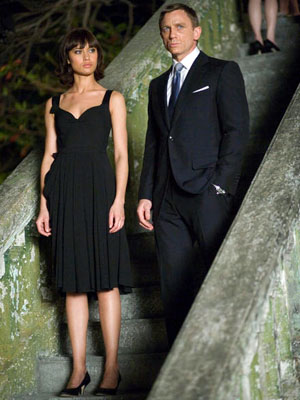The Sunday Times
by Cosmo Landesman
The big question that has always dominated
debate among James Bond aficionados has been this — who is the greatest
007 of them all?
Now, with the second film in the relaunch of the franchise, they must face
a new question — is Quantum of Solace the most boring Bond film
ever?
Following Casino Royale was never going to be easy, but the
director Marc Forster has brought the brand’s successful relaunch crashing
back to earth — with a yawn. Even we Bond agnostics could see that Royale
had its memorable moments, but Quantum of Solace is $200m worth of
bland crash-bang-wallop. It’s an action film on autopilot, one that
produces instant amnesia. By the time you have left the cinema, you won’t
remember a thing. The trick, of course, is to get a balance between the
Bond formula and something fresh. Every time Forster tries to push the
feelgood buttons of Bond’s glorious past, however, he totally misses the
mark, depriving us of traditional treats. It’s like a panto without a
wicked witch. |
 |
|
Consider the Bond theme
song. Why is it so difficult to write a decent Bond tune? (Answer:
because, in the days of John Barry, nobody worried about market
demographics.) The latest concoction, 'Another Way to Die', performed by
Alicia Keys and Jack White, is a soulless slice of rock’n’soul sludge. The
opening credits, featuring female body shapes emerging from desert sands,
look like a cheesy 1970s television ad for a brand of cheap scent. For the
big opening scene — a key feature of the Bond film — what do we get? A car
chase you can’t enjoy, because the cars and characters disappear in a blur
of frantic editing.
From this point in, it’s all downhill. The screenplay, by Paul Haggis (Crash),
Neal Purvis and Robert Wade, is at times incomprehensible. It’s assumed
that you know Casino Royale by heart and understand the intricacies
of Bond’s relationship with his true love, the late Vesper Lynd. Did she
betray him or try to save him? Search me, guv.
And it’s unclear what her relationship was to the secret organisation Bond
and MI6 are trying to penetrate, headed by the eco-champion Dominic Greene
(Mathieu Amalric), who wants to take control of the water supply of the
whole of South America. Greene is a thug who topples governments at the
click of his fingers, abolishes the minimum wages of factory workers and
sells great hunks of the rainforest for a fast buck. This is a Bond
villain? It’s the perfect CV for a career at the World Bank.
Then there is 007 himself. James, what have they done to you? He has been
stripped of any traces of charm, wit or intelligence, and is just another
modern hero, concerned only with his own hang-ups and emotional issues.
Feelings of grief and guilt over Vesper — not any notion of duty — propel
him into action. He’s a thug with a broken heart, trying to find closure
through killing. James, get over it and get back to work. Would any kid,
or middle-aged fantasist, want to be like this back-to-basics Bond? The
glamour is gone; the crack of broken bones has replaced the clink of
martinis. In the most recent film, we saw his testicles whipped; here,
they are removed. Not, I hasten to add, by a villain, but by the
screenplay. The great thing about being 007 is that you get to sleep with
beautiful women — all the time. In the new age of Bond realism, however,
he gets a quickie with Agent Fields (Gemma Arterton) and nothing with his
leading lady, Camille (Olga Kurylenko). Bond directors, take note: more
sex, please, we’re British.
At the heart of the story is a question: who can you really trust? The
Bond series has finally embraced what might be called John le Carré
relativism: the notion that the “good” guys are as morally grubby as the
“bad” guys. Indeed, one of the characters says, “There is no good and
evil” — as if this were a daring proposition. Yet every film these days
says it. It would be more daring to suggest that there are no shades of
grey, only right and wrong. So, Bond ends up being hunted by both MI6 and
the CIA as if he were the villain.
You would expect some memorable performances from an actor’s director such
as Forster — the man who made Halle Berry look talented in Monster’s
Ball — but the casting is a mess. Kurylenko is cute and capable, but
Amalric, while he looks like a young Polanski, has the menace of a mouse.
The weakest link, though, is Craig. Yes, he looks good in a tuxedo, and is
terrific when it comes to action sequences. Paradoxically, however, even
though we’re meant to have a very human Bond on display, he moves through
the film with the cold, mechanistic manner of Schwarzenegger’s Terminator.
No comic quips or human touches are capable of piercing the armour of
those tight, puckered lips. In Craig, the 007 franchise has found a great
face (and body), but it has not found a voice or a visual style it can
call its own. Bond has been stripped of his iconic status. He no longer
represents anything particularly British, or even modern. In place of
glamour, we get a spurious grit; instead of style, we get product
placement; in place of fantasy, we get a redundant and silly realism.
Craig makes an attractive corpse, but Bond is dead. 2/5 |

